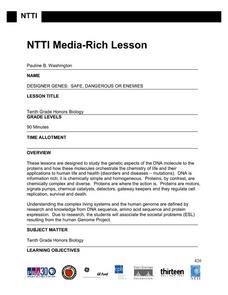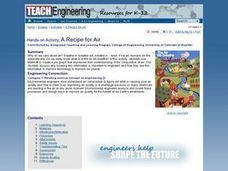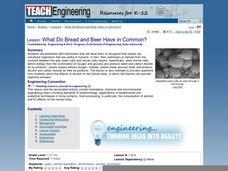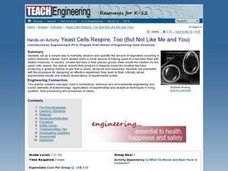Curated OER
Jobs
Students discuss jobs that could make you happy or unhappy and read articles about people who are happy and unhappy in their jobs. For this jobs lesson plan, students also match jobs to things they work with.
Teach Engineering
Get Me Off This Planet
What do Newton's Laws have to do with getting from Earth to Mars?The activities in this resource show how Newton's Laws work with rockets to get them into space. Background information includes facts about orbits and how orbits...
Curated OER
Temperature and the Tomato
You will need a photovoltaic system and monitor at your school in order to obtain all of the data required to thoroughly implement this lesson. Your class monitors daily temperature and insolation amounts over a two week span of time....
Curated OER
Fire Brigade
Students examine how a community works together to protect them from fire. They work together to design a functional tool that could be helpful in fighting fires. They share their tool with the class.
Curated OER
Antacid Tablet Race
Students complete experiments to determine how rocket fuel is affected by surface area and temperature. They compare the reaction rates of antacid tablets. They discuss their results to complete the lesson.
Curated OER
Which Side to Choose? An Exercise in Choices and Ethics
High schoolers evaluate their reaction to a series of statements to investigate that personal choices are based on personal goals, peer and social pressures, ethic and religious beliefs, and the knowledge of biological consequences. This...
Curated OER
Stem Cell Differentiation Game Questions
Thirty-five multiple-choice questions are spread out into boxes bordered with dotted lines so that they can be cut out to become game cards. Playing a game to review concepts is an effective way to learn, even if you are in college. Give...
Curated OER
An Underground River
Seventh graders describe how water flows through the ground, what an aquifer is and what soil properties are used to predict groundwater flow. They consider the affects of pollution on groundwater supplies and write a letter drawing...
Curated OER
Where Does All the Water Go?
Students view a demonstration of how groundwater flows and define several related vocabulary terms. They complete a worksheet, participate in discussion and make a poster.
Curated OER
Blast Off!
Fourth graders investigate the third law of motion. In this third law of motion lesson plan, 4th graders explore the forces necessary for a rocket to launch. Students compare and contrast propellant and fuel. Numerous resources are...
Curated OER
Forcing Electrons to Move
In this electrolytic cell worksheet, high schoolers read about car batteries and how they produce electricity for cars to run. They answer six questions about electrolytic cells and oxidation-reduction reactions.
Curated OER
A Recipe for Air
Students create a pie graph using M&Ms to demonstrate the composition of air. They label each section of the graph, and list the fractions from largest to smallest.
Curated OER
Batteries
In this battery activity, students answer 14 questions about primary cell batteries, secondary cell batteries, and how batteries are charged. They calculate the rates of discharge for given batteries.
Curated OER
The Dirty Water Project
Students investigate different methods (aeration and filtering) for removing pollutants from water. They design and build their own water filters. Students identify the pollutants in a water sample using sight and smell, explore what...
Curated OER
What's Air Got to Do with It?
Students use M&M's to create a pie graph that expresses their understanding of the composition of air. They watch and conduct several simple experiments to develop an understanding of the properties of air (it has mass, it takes up...
Curated OER
How To Make Yeast Cells Thrive
Students set up and run the experiments they designed in the lesson, 'Population Growth in Yeasts,' using simple yeast-molasses cultures in test tubes. They demonstrate understanding that several environmental factors can contribute to...
Curated OER
What Do Bread and Beer Have in Common?
Students listen to an explanation of yeast cells and how they effect bread and beer. They discuss the ways alcohol affects the human body and participate in an indirect observation about cell respiration in yeast-molasses cultures.
Curated OER
Steamship Portland: Where's the Energy?
Students examine how steamships operate. They describe the necessary energy conversions. They construct a model paddlewheel ship. They use rubber bands as examples of potential and kinetic energy as they unwind and set the models in motion.
Curated OER
Tracking a Virus
Students simulate the spread of a virus such as HIV through a population by "sharing" (but not drinking) the water in a plastic cup with several classmates. Although invisible, the water in a few of the cups will already be tainted with...
Curated OER
TE Activity: Yeast Cells Respire, Too (But Not Like Me and You)
Student observe and quantify the respiration that occurs in yeast-molasses cultures. They complete an effective experiment in order to examine how to think critically about the results.
Curated OER
Introduction to Chemistry
In this introduction to chemistry activity, students answer 9 questions regarding the study of chemistry. The first part is matching, then they "think like a scientist" and then they problem solve.
Curated OER
The Tobacco Time Bomb: What's In A Cigarette?
For this enlightening and disturbing health lesson, young scholars read and discuss information on smoking and closely-look at the ingredients in a cigarette. You will be amazed at the list of ingredients that are found in cigarettes....
Curated OER
The Challenge to Deliver Insulin
Students study the types of diabetes and why insulin is important. In this diabetes instructional activity students build molecular models and create a healthy lifestyle plan.
Curated OER
Heat Transfer and Pollution
Students perform computer simulations on air dispersion. In this chemistry lesson plan, students calculate energy transfer based on specific heat and temperature change. They explain the causes of smog.

























